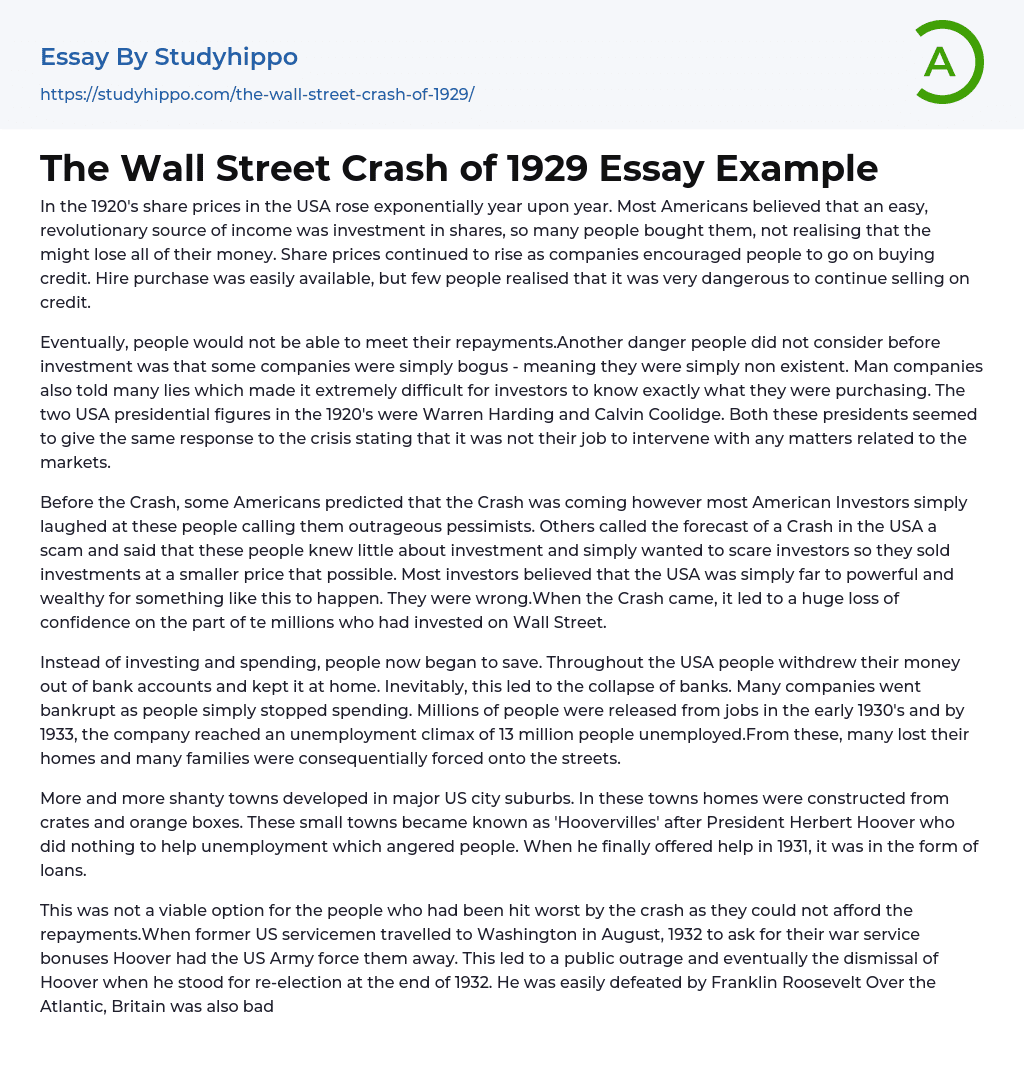Throughout the 1920s, there was a steady and swift rise in stock prices in the United States. The common belief among Americans was that investing in stocks was an innovative and profitable method of generating income. Consequently, numerous individuals purchased stocks without realizing they were placing themselves at risk of losing their entire investment. Companies persisted in encouraging people to buy shares on credit, which led to further increases in stock prices. Although installment plans were readily available, few people understood the potential dangers associated with continuing to sell stocks on credit.
The financial crisis of the 1920s had multiple causes. Borrowers were unable to pay back their loans, while investors failed to anticipate risks associated with fraudulent companies and false statements made by numerous corporations. During this time, Warren Harding and Calvin Coolidge served as U.S. Pr
...esidents and both declined to intervene in market affairs.
Although some Americans provided warnings about the Crash, many investors in the US ignored them and instead labeled these individuals as pessimists or even scammers who had limited knowledge of the investment market. These investors held a belief that the USA was too strong and prosperous to experience a crash, which ultimately created a false sense of security. Nevertheless, when the Crash did take place, it resulted in an extensive decline in confidence for numerous Wall Street investors.
The American population shifted from investing and spending to saving, causing a domino effect of bank withdrawals and subsequent bank collapses. This decrease in spending resulted in widespread bankruptcy and job loss, with over 13 million people unemployed by 1933. The negative impacts extended to housing, as many families were left homeless.
Suburban area
of major cities in the US experienced a rise in shanty towns where residents constructed homes from orange crates and boxes. Dubbed as 'Hoovervilles', these towns were named after President Herbert Hoover who drew public ire for his perceived lack of action on unemployment. In 1931, he eventually offered assistance in the form of loans.
The option of repayment became unfeasible for those who suffered the most from the crash. In August 1932, ex-soldiers appealed for their war service bonuses in Washington but were turned away by the US Army, causing public outrage. Consequently, Hoover lost his re-election bid at the end of 1932 and was defeated by Franklin Roosevelt. Additionally, Britain was severely impacted by the Wall Street Crash.
Major industrial cities such as Manchester, Liverpool, and Birmingham were severely impacted as the shipbuilding, coal, steel, and textile markets suffered a downturn. Unemployment rates soared as orders for new ships came to a halt due to the absence of world trade. The decline in shipbuilding had a ripple effect on the coal and steel industries, which heavily relied on it for their orders. Additionally, Asian producer countries like India, China, and Japan began producing cotton and wool more affordably, causing the textile industry to suffer. To make matters worse, these countries started mass-producing synthetic fiber textiles as well.
Britain had previously been exporting naturally occurring cotton and wool products, but they were cheaper, easier to wash, and more durable alternatives. As a result of the collapse of the British Raw Material Industries, cities and areas where these industries were located suffered greatly. The coal decline had a particularly devastating impact on South Wales and Newcastle,
while Jarrow is the most famous example of unemployment reaching over 80%. This led to the infamous "Jarrow to London Hunger March". All of these terrible consequences were caused by investors who failed to fully understand the terms of their investments.
As the 2008 worldwide 'Credit Crunch' takes hold, it is important for both International Governments and Individuals to take steps to prevent a recurrence of such a crisis. While generating additional income to cover an impending recession is a good idea, it is important to be mindful of media hype that may contribute to economic downturns. The best option is to prevent recession from occurring in the first place.
- Investing essays
- Asset essays
- Depreciation essays
- Discounted Cash Flow essays
- Foreign Direct Investment essays
- Funds essays
- Internal Rate Of Return essays
- Revenue essays
- Day Trading essays
- Futures Trading essays
- Capital market essays
- Million essays
- Payment essays
- Rate Of Return essays
- Funding essays
- Hedge Fund essays
- Abortion essays
- Abuse essays
- Animal Rights essays
- Animal Testing essays
- Assault essays
- Bullying essays
- Controversial Issue essays
- Crash essays
- Cyber Bullying essays
- Feminism essays
- Human Rights essays
- Immigration essays
- Inequality essays
- Poverty essays
- Prejudice essays
- Racism essays
- Torture essays
- Violence essays
- Bank essays
- Banking essays
- Corporate Finance essays
- Credit Card essays
- Currency essays
- Debt essays
- Donation essays
- Enron Scandal essays
- Equity essays
- Financial Accounting essays
- Financial Crisis essays
- Financial News essays
- Financial Ratios essays
- Financial Services essays
- Forecasting essays
- Foreign Exchange Market essays




